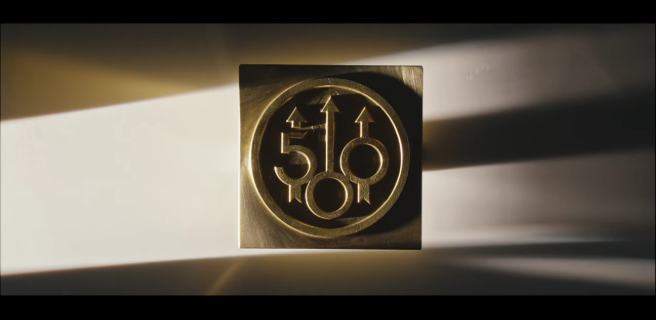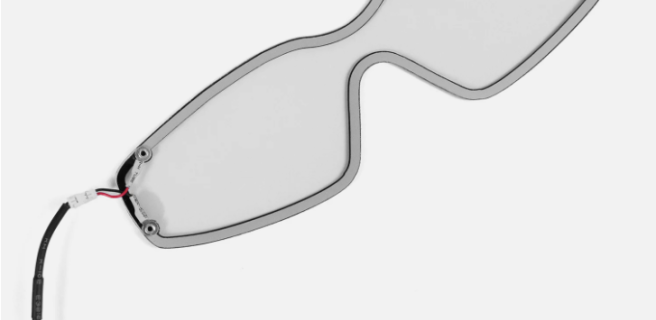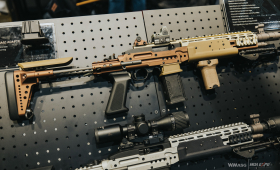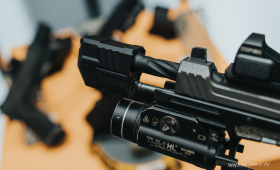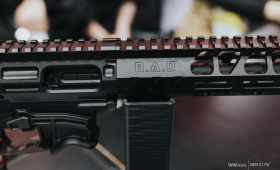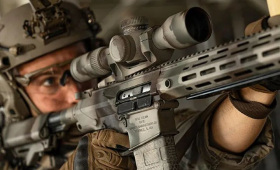When choosing a wristwatch for use in sport related activities we are presented with an abundance of choices. Smartwatches are also becoming more and more popular. Companies that were specializing in geolocation are releasing their own advanced watches that are also equipped with GPS modules. New companies have also emerged. On the competitive market, the basic watch function is pushed aside. All that matters are additional functions and a picky user has an increasingly broader choice. A wristwatch has become a specialized tool for most outdoor and sport activities. More often then not, it is an advanced workstation, a user's assistant. However, the G-shock series of wristwatches by Casio still remains a classic choice.
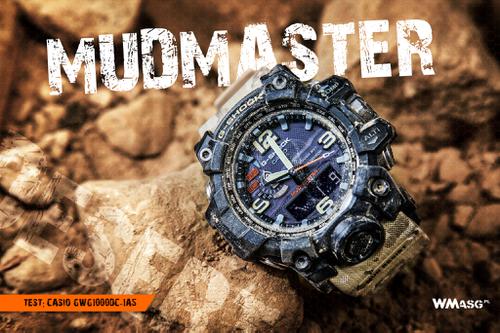
G-shock
The line has been started at the end of the 1980s by Kikuo Ibe, an engineer working for Casio, and is still the most recognizable design standard among watches for active people. Initially, the watches from the G line were to withstand a fall from 10 meters. Today, they are able to bear much more. The G-shock series has gained initial popularity in the USA, today cheaper and more expensive models can be seen on hand of people regardless of the place or circumstances. Mr Kikuo probably did not expect to start a timeless fashion. And this is not just a meaningless fashion. It comes from the simple yet robust design of the said watches, which makes them very popular among special forces soldiers around the world, including Poland.
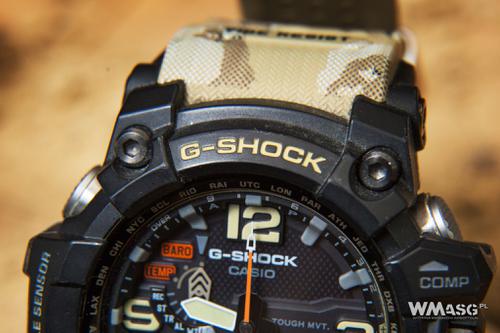 Many models are made and all are divided into lines depending on their purpose. They offer different functions and various dedicated resistances to adverse environmental conditions (apart from impacts and shocks) such as corrosion or mud. The model reviewed by us belongs to the Mudman family, wristwatches for playing in mud. Each line has its flag product and I have the pleasure and pride to be reviewing one of them. We will test the representative of the Master of the G line - the Mudmaster (GWG-1000DC-1A5) model from the newest Desert Camouflage collection (it includes the Mudman, Rangeman, Mudmaster models). The Mudmaster GWG-1000 model has been first released in March 2015, but the word premiere of the Desert series took place more recently, in September 2016 and hit the Polish market at the end of last year.
Many models are made and all are divided into lines depending on their purpose. They offer different functions and various dedicated resistances to adverse environmental conditions (apart from impacts and shocks) such as corrosion or mud. The model reviewed by us belongs to the Mudman family, wristwatches for playing in mud. Each line has its flag product and I have the pleasure and pride to be reviewing one of them. We will test the representative of the Master of the G line - the Mudmaster (GWG-1000DC-1A5) model from the newest Desert Camouflage collection (it includes the Mudman, Rangeman, Mudmaster models). The Mudmaster GWG-1000 model has been first released in March 2015, but the word premiere of the Desert series took place more recently, in September 2016 and hit the Polish market at the end of last year.
Mudmaster – simply the master
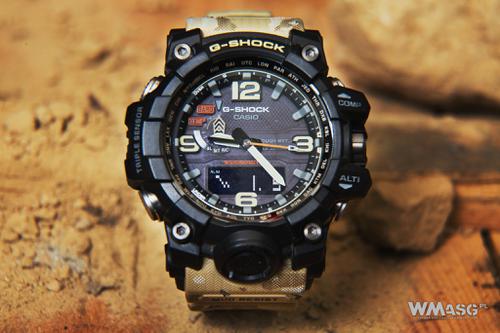 The case of the watch is made from a low mass polymer compound. The strap is very wide and robust, as are the lugs which use hex screw to fasten the strap to it. The watch is massive and it weight in noticeable on one's hand, which can be both an asset or a flaw. It weighs 117g. Because of its size it sometimes happens that it gets in the way while putting a backpack on, yet, despite this, it is comfortable and easy to read even in severe weather conditions. The case's back is made of stainless steel, and the crystal with an anti-reflective coating and a very high scratch resistance has been made from sapphire glass made on the basis of aluminum oxide (Mosh scale resistance ranging from 7 to 9). Metal function buttons are very big and easy to use. This should be appreciated by people that have big hands. It can be used wearing gloves without any problems. On the left side the Triple Sensor has been placed, which is responsible for taking terrain parameters measurements. On the right is a screwed on crown with an O-ring, which is used to personalize the setting of individual functions of the watch.
The case of the watch is made from a low mass polymer compound. The strap is very wide and robust, as are the lugs which use hex screw to fasten the strap to it. The watch is massive and it weight in noticeable on one's hand, which can be both an asset or a flaw. It weighs 117g. Because of its size it sometimes happens that it gets in the way while putting a backpack on, yet, despite this, it is comfortable and easy to read even in severe weather conditions. The case's back is made of stainless steel, and the crystal with an anti-reflective coating and a very high scratch resistance has been made from sapphire glass made on the basis of aluminum oxide (Mosh scale resistance ranging from 7 to 9). Metal function buttons are very big and easy to use. This should be appreciated by people that have big hands. It can be used wearing gloves without any problems. On the left side the Triple Sensor has been placed, which is responsible for taking terrain parameters measurements. On the right is a screwed on crown with an O-ring, which is used to personalize the setting of individual functions of the watch.
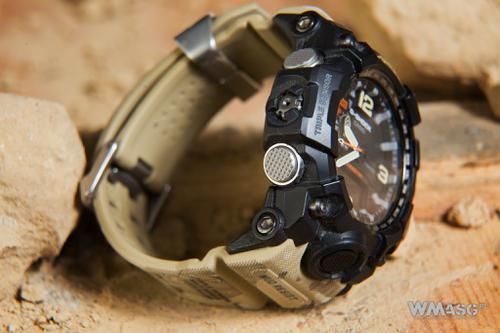
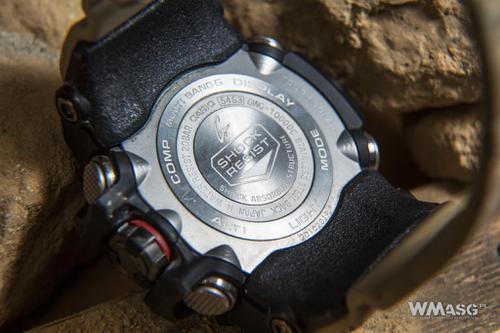
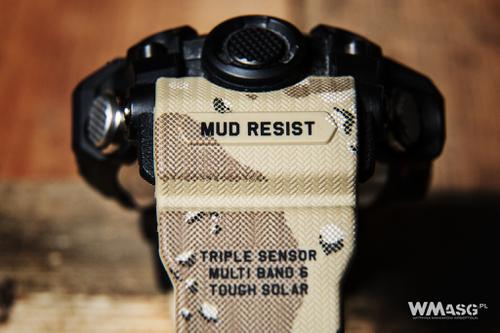
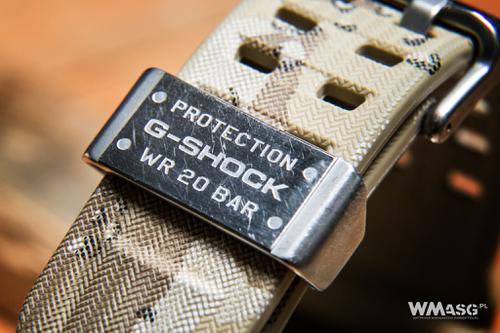
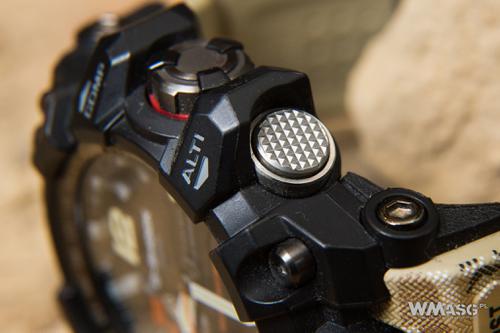
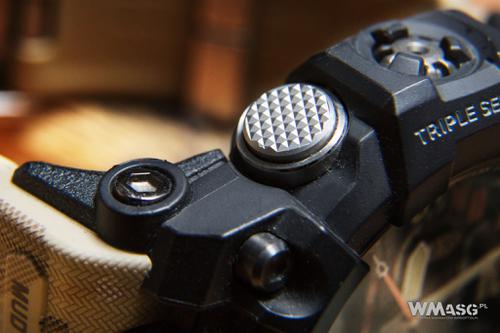
Today it is not so obvious but for me, the thing I put on my hand, is first and foremost a watch and the workstation is its secondary function. The Mudmaster series models are many and all have different colours. The advantage of this model over the cheaper G-shock models is the use of hands that make it easier to read the time and some other measurements. They also very elegantly reveal the data on the display after this function is activated and add to the watch's distinct look. Some cheaper models also come with hands but the gel immersed mechanism of the reviewed watch is much more resistant. The Mudmaster also has in built-in autocorrection of misaligned hands which may result from exposure to a strong magnetic field or an extreme impact.
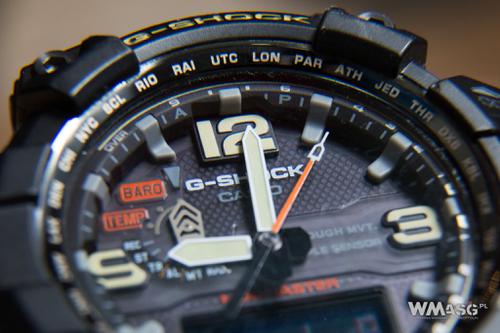
In the GWG-1000DC-1A5 the dial's colour matches the strap, which is a loose interpretation of the Desert 6-colour camo. The sand coloured hands are placed against a black dial with very big 12, 3, 6, 9 digits. The black and orange second hand is made from carbon fiber and resembles the style of certain parts of the dial, especially the „Mudmaster” sign (if we were to forget what kind of watch we are wearing). The hour marks and the hands are covered with a fluorescent paint. Reading time at night is additionally facilitated by the LED illumination placed in the lower part of the dial.
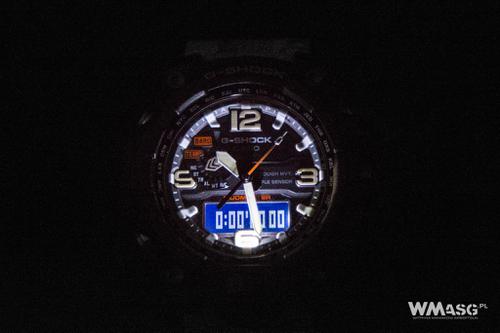
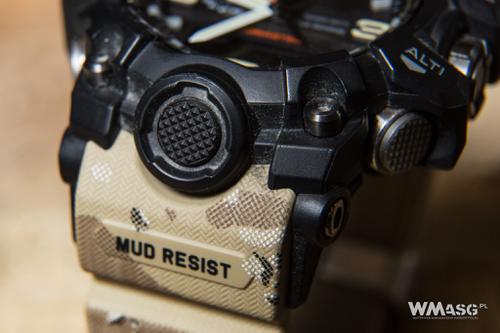
The watch will show the proper time in the majority of places on Earth since it is synchronized via radio (WaveCeptor) with atomic clocks. The closest one to Poland is situated in Germany. Despite the manual specifying that the watch should me synchronized away from thick walls and electrical devices, which can scramble the signal, I had no problems doing it in the heart of Cracow, inside an apartment near the Main Square. Of course, this function can be turned off if desired.
The dial also has an LCD with a dark background and light digits. In the normal mode the display shows just the date, the date and the air pressure difference graph or the time. It main function is to present readouts of the watch's various functions.
The Mudmaster has a total of 11 of those. Apart from a clock, a date, a stopwatch, a timer (which is not as obvious as one might think) and an alarm clock (with 5 alarm settings), the watch can show the time for a second time zone, which is easy to swap with the main one, and can be chosen from 29 preprogrammed time zones. Once such function seemed like a redundant gadget for me, especially when the watch sets itself via radio and a normal person can add and subtract from twelve since primary school. Yet, this is simply convenient, especially when one has a constant contact with people from different time zones.

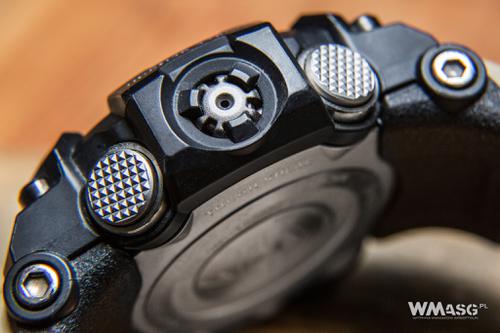 The Triple Sensor - one of the most important features of the Mudmaster, it is responsible for taking terrain parameters measurements. The thermometer shows the temperature in the range between -10oC (unfortunately the thermometer does not work right in lower temperatures) and 60oC. Also, it works best when taken off one's wrist. It can be calibrated to the temperature of the user's hand but it is not constant so measuring the temperature should be always be made when the watch of off one's hand.
The Triple Sensor - one of the most important features of the Mudmaster, it is responsible for taking terrain parameters measurements. The thermometer shows the temperature in the range between -10oC (unfortunately the thermometer does not work right in lower temperatures) and 60oC. Also, it works best when taken off one's wrist. It can be calibrated to the temperature of the user's hand but it is not constant so measuring the temperature should be always be made when the watch of off one's hand.
The barometer or a personal weather forecast, apart from the compass, is the most useful feature while being outdoors. It works in the range between 260 and 1100 hPa. Thanks to a graph showing the changes in the air pressure every two hours we are able to make a weather forecast. As we all know, the clouds on the horizon can often be an ill omen but when using this function we can, with great accuracy, tell if they are just bluffing or if it will be a time to take a cold shower. Another useful feature is the alarm that sets off when a sudden change of pressure is detected. Personally, I have never been disappointed by the indications of the Casio barometers.
The altitude meter, despite the fact that it work in the range between -700m to 10000m, works on the basis of measuring the air pressure and can therefore only be an approximate altitude indicator. Since water pressure is more stable and reliable it will work better underwater, yet it is only recommend for recreational diving. In the mountains, for example, we can find out that we went down 40m while we were asleep, all because of the air pressure changes, which might be good news, but... Therefore, constant calibration with the external data is needed. Moreover, the watch has an built-in memory which can store up to 30 measurement. The height measurements can also be saved automatically.
The third „measurement” is the compass. It works well and can also be calibrated. The magnetic needle is replaced by the second hand. It is not a magnetic compass but it works. It is a useful function in any circumstances, in the city or in the country, especially that we do not always carry a regular compass with us.
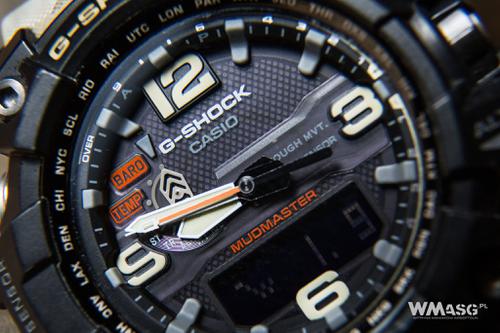 What sets the Mudmaster apart from the older model is the Tough Solar quartz mechanism, the most modern technology of acquiring solar energy and charging the battery. The power is gained from miniature photovoltaic cells installed in the dial which in practice, or at least in theory, means that we will never have to visit a watchmaker to replace a drained battery. The bright sunlight in not a requirement but charging the battery in other weather conditions is much less efficient. According to the manufacturer, a few minutes on direct sunlight or a few dozen on a cloudy day is enough to meet the watch's daily power requirements. Charging is also possible using artificial light, but it will take longer and will only ever charge the watch to the M (Medium) level. The battery charge level can be checked at any time. Overall, it is recommended to wear the watch exposed to the sunlight. But really, who would like to hide the Mudmaster under the sleeve?
What sets the Mudmaster apart from the older model is the Tough Solar quartz mechanism, the most modern technology of acquiring solar energy and charging the battery. The power is gained from miniature photovoltaic cells installed in the dial which in practice, or at least in theory, means that we will never have to visit a watchmaker to replace a drained battery. The bright sunlight in not a requirement but charging the battery in other weather conditions is much less efficient. According to the manufacturer, a few minutes on direct sunlight or a few dozen on a cloudy day is enough to meet the watch's daily power requirements. Charging is also possible using artificial light, but it will take longer and will only ever charge the watch to the M (Medium) level. The battery charge level can be checked at any time. Overall, it is recommended to wear the watch exposed to the sunlight. But really, who would like to hide the Mudmaster under the sleeve?
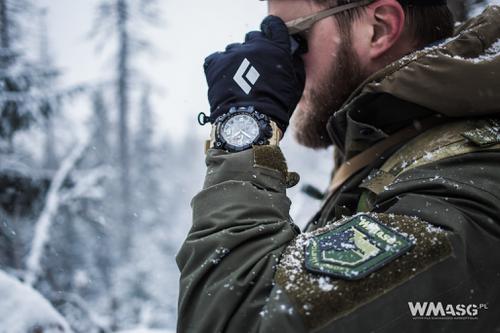
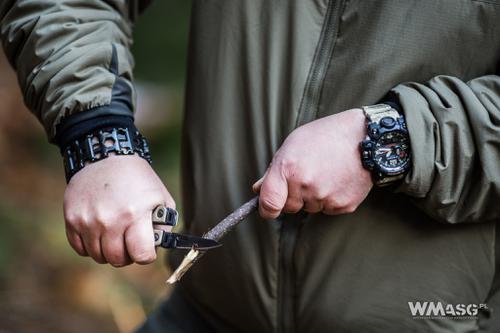 The model described by here, in my opinion, is a perfect example of what a man can expect from an outdoor watch. It is still a watch. A watch that does not need any care or charging once per day. It can endure much or even everything. It is a watch for everyday use, for outdoor use or just to show off, for mountain trips, training sessions, the shooting range, sailing, swimming (water resistance up to 20BAR) or any other activities, especially extreme ones, where there is a lot of mud. Starting with the aggressive, strong yet aesthetic and pleasing design and ending with the number of function offered.
The model described by here, in my opinion, is a perfect example of what a man can expect from an outdoor watch. It is still a watch. A watch that does not need any care or charging once per day. It can endure much or even everything. It is a watch for everyday use, for outdoor use or just to show off, for mountain trips, training sessions, the shooting range, sailing, swimming (water resistance up to 20BAR) or any other activities, especially extreme ones, where there is a lot of mud. Starting with the aggressive, strong yet aesthetic and pleasing design and ending with the number of function offered.
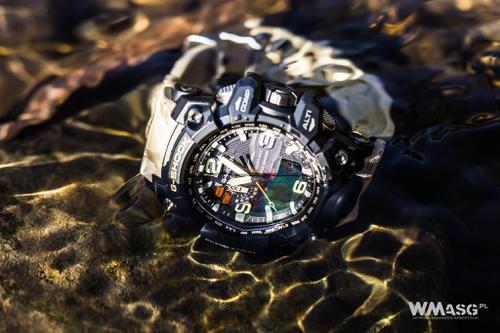
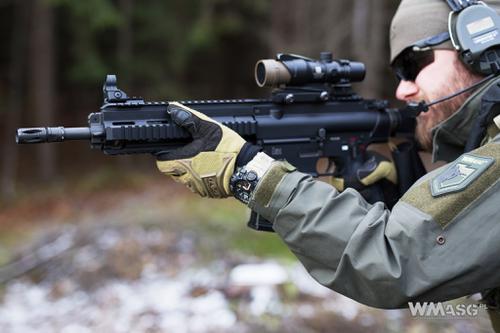 The Mudmaster is a massive watch which will better fit a larger hand (the case dimensions are 59,5 mm × 56,1 mm × 18,0 mm). Using it outdoors is a pleasure. It has exactly everything I happened to use in a watch over the past couple of years. The robustness and functionality, coupled together with a solar charged battery, make it the best companion during any trip.
The Mudmaster is a massive watch which will better fit a larger hand (the case dimensions are 59,5 mm × 56,1 mm × 18,0 mm). Using it outdoors is a pleasure. It has exactly everything I happened to use in a watch over the past couple of years. The robustness and functionality, coupled together with a solar charged battery, make it the best companion during any trip.
Knowing our reality, they only problem might be its price. On one hand it is adequate (as it is the top model of the line), on the other, when considering it as a typical sport watch, there are cheaper options to choose from, even from Casio's offer. But this watch is a living legend, a class of its own, which some will understand and appreciate and some will not. While reading various foreign forums, I noticed many people willing to buy this watch. Will the same situation be true in Poland?





